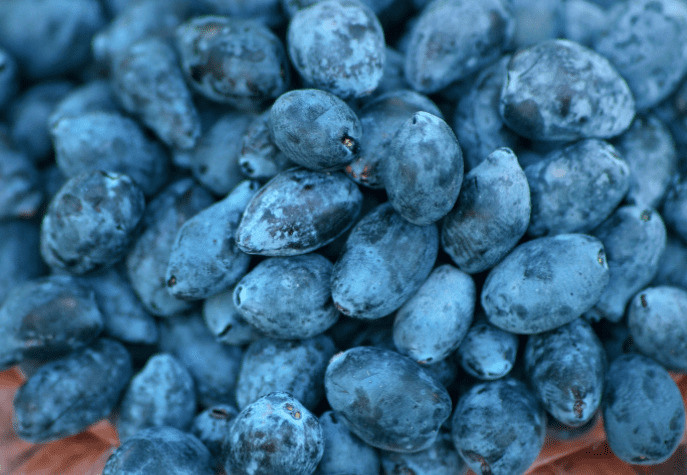Honeyberry
There’s a new berry in the berry patch, and it’s called the honeyberry or sweet berry (haskap) and sometimes called blue honeysuckle as it is edible honeysuckle.
The berries are similar looking to blueberries but are more elongated. The berries don’t have the seeds or the skins like blueberries as the skins melt in your mouth. The texture and seeds of the sweet berry can be compared to the kiwi fruit.
The distinct taste is like eating a raspberry and blueberry mixed. The berries are great for eating fresh or frozen, making excellent pies, jams, juice, and wine.
They are also easy to add color and flavor to ice cream, yogurt, and smoothies. They are a healthy food choice as they are high in vitamin C and antioxidants.
The sweet berry is relatively new to North America and was recently developed at the University of Saskatchewan.
It did very well there and is now available throughout Canada, where it is growing productively and picking up in popularity.
We had some available at the nursery last year, and this year there is a good supply.
The plants grow 1.5 meters high and wide depending on the variety and have an excellent rounded shape.
Honeyberry Propagation
Producing honeyberries necessitates the cooperation of two plants. To pollinate successfully, the plants require the presence of an unrelated shrub nearby.
In two to three years, the plant roots quickly from dormant stem cuttings and fruits. Cuttings will produce plants that are genetically identical to the parent strain.
Cuttings can be rooted in water or the ground, ideally in a soilless combination, until they have grown a healthy cluster of roots. Then, on a prepared bed with sufficient drainage, transplant them.
The plants like moderately wet, pH 6.5, and organically amended mixtures. Soil can be sandy, clay, or practically any pH level, but they prefer moderately moist, pH 6.5, and organically amended mixtures.
Scarification or stratification are not required for seed treatment. Honeyberry plants propagated from seed produce a variety of species and take longer to fruit than stem cutting plants.
Honeyberry Planting Instructions
Arrange plants 4 to 6 feet (1.5 to 2 m.) apart in a sunny position and seed them at the depth they were initially planted or deeper in improved garden beds. Make sure there’s another honeyberry variety nearby for cross-pollination.
Water regularly, allowing the soil’s top layer to dry out between irrigations during the first year. Mulch the plant’s root zone 2 to 4 inches (5 to 10 cm) deep with leaf litter, grass clippings, or other organic compost.
Competitive weeds will be kept at bay as well. In the spring, add nutrients with compost or manure. Fertilize based on the outcome of a soil test.
Pest And Diseases
They are seldom bothered by pests or diseases and do not need a lot of care or pruning once established. When they are first planted, they should be watered periodically until the root system is developed, but once they have a good root system, the plant is easy to care for.
They also do not take over the yard as they do not sucker, another bonus. Plant them in sunny to partial shade spots.
When purchasing sweet berry bushes, you should choose at least two bushes of different varieties as they need to cross-pollinate.
(If you are limited with space, there are bushes available called combo plants with two varieties together). Plant bushes 1.5 to two meters apart for good cross-pollination.
You can also make a hedge with them, and then they should be planted closer together—each bush, in total production, can produce five to 10 kilograms depending on the variety.
HoneyBerry Harvesting
Another nice thing about sweet berries is how early in the season they produce.
Honeyberries are among the earliest fruits to mature and can be harvested in mid to late June.
By late April or early May, the bush is in full bloom, and the frost does not harm the flowers, which can be a problem with some of the other early flowering fruits as a late spring frost can damage or destroy fruit protection later in the season.
The berries are easy to pick as the bushes do not have thorns on them and to tell if the berry is ripe, cut one open, and if it is still green inside, it is not ready to harvest yet. They need to be purple inside to be grown.
I am excited about this new sweet berry, and I know that other people are as well because I’ve already had a lot of local gardeners coming into the greenhouse and asking about them.
Last fall, we planted a combo plant in our yard, and already it is in the whole leaf. The flower buds are visible and will soon be open.
This shows how early and hardy the plant is because there is no other shrub or tree in our yard with foliage. Over the winter, we lost a few shrubs and roses due to the cold temperatures we experienced last November, yet the sweet berry is doing great with no winter kill at all!























